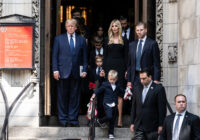More than mere weapons, guns serve many real and imaginary purposes in the minds of Americans.
Donald Trump is a professional troublemaker. Not even Republicans will deny that. As Paul Ryan scrambles to avoid a trade war provoked by Trump’s persistent intention to deploy his art of the geopolitical deal, Republicans are also having trouble digesting Trump’s apparent about face on gun control.
Concerning the tariffs on steel and aluminum, Trump’s long promised but nevertheless unexpected initiative “caused a panic among members of his own party, who tend to oppose creating trade barriers of any kind around the US economy.” The Donald’s shifting stance on gun control created an enormous surprise as he violated a major taboo by daring to remark that Republican legislators were “petrified” by the influence of the NRA. That was before agreeing to a meeting with that organization the following day and doing his best afterward to disguise his own petrification by affirming that he “was in favor of leaving the matter up to the states.”
Not even the media, avid to follow all the vagaries of Trump’s whimsical presidency, could keep up. In the course of several days Trump managed to first upset members of his own party while seemingly flattering Democrats, then reassured Republicans while outraging the Democrats, and then astonishing everyone, including Tucker Carlson at Fox News, when he expressed his wish to seize the weapons of risky gun owners, thereby calling into question the sacred notion of due process. In a style closer to Rodrigo Duterte than Barack Obama or even George Bush, the president confided, “I like taking the guns early. Take the guns first, go through due process second.”
Debate, Conversation or Black Humor?
Weeks after the Parkland shooting, the debate about gun control appears still to be alive, either despite or because of the confusion Trump has created. The latest persuasive factor is the growing revolt of the students themselves. This is a novelty in US politics. The pattern in the past has always been wailing and gnashing of teeth for several days, impassioned calls for action immediately dismissed by gun fanatics as too influenced by the emotion of the moment, followed by … nothing. Even those who were initially overcome by emotion expected soon to be numbed by the predictable inaction of the politicians.
The statistics have long been in favor of reinforcing gun control, with a majority of Americans favorable to “stricter laws on assault weapons,” whatever that may mean (short of an outright ban). An inveterate optimist writing for the Huffington Post believes serious gun control legislation could pass, citing these figures: “A majority of Trump voters, 52 percent, now say gun laws could be tightened without violating the Second Amendment, up from 43 percent immediately after the Parkland shooting and just 33 percent after last year’s Las Vegas shooting. Among Republicans, the number is currently 61 percent, up from 42 percent last fall.” The key phrase in this bit of wishful thinking is “without violating the Second Amendment,” which presumes that someone in Washington — and especially the Supreme Court — understands what the Second Amendment means.
As The Washington Post points out, the law of strategic silence will most likely once again counter all such hopes. As we pointed out in a recent edition of the Daily Devil’s Dictionary, politicians routinely suggest that this burning question requires not so much action as a “conversation.” The Post cites the case of Republican Dean Heller who “looks forward to continuing discussions with his colleagues” before reaching the obvious conclusion: “without this silent majority’s support, there is little chance for significant gun control legislation to become federal law, no matter how loud the outcry from high school students and others who are pushing for action.”
Karl Rove affirms that “there’s no chance of an assault weapons ban,” after reminding us that in 2004 it was defeated in the Senate by a vote of 90 to 8. He is undoubtedly right on the question of assault weapons. But this time around, some minor measures of gun control may go through, on condition that they have no real effect on controlling the sale and use of guns or in any way modify people’s attitudes about guns as the ultimate means of personal expression, a given in the culture, reinforced on a daily basis by Hollywood and TV.
It’s easy enough to change the laws, but a lot more challenging to change a culture. Because Trump doesn’t play by the rules — unlike Obama, who publicly wept at every school shooting — the ambient confusion he has created means that the chances of some kind of reform now seem to be about 50/50. But whatever happens, today’s gun culture will not only endure but may even become more violent. Historical trends, especially when they mobilize emotion-packed memes, exist and are worth studying, even for Americans, who prefer to “look forward, not backward.”
Making Sense of US History
The history of the United States since 1787 and the ratification of the constitution, like Julius Caesar’s Gaul, can be divided into three parts or, in this case, roughly three centuries. The first lasted less than a century, four score and eight years. It ended in 1865, a year after Gettysburg, with General Lee’s surrender at Appomattox after the last battle of the Civil War. That marked the moment when the name of the nation switched from plural to singular.
Before 1860, when the nation dramatically split in two, the United States were precisely that — an association of states that had agreed to be united against the outside world but autonomous within their borders. In speech and writing, people would say “the United States are” rather than “the United States is.” This held true until shortly after the Civil War. An article in The Washington Post of April 24, 1887 described and explained this radical but sometimes unnoticed shift. “The war changed all that. Along the line of fire from the Chesapeake to Sabine Pass was settled forever the question of grammar. Not Wells, or Green, or Lindley Murray decided it, but the sabers of Sheridan, the muskets of Sherman, the artillery of Grant. … The surrender of Mr. Davis and Gen. Lee meant a transition from the plural to the singular.”
Such a change in the conception people have in their minds of the nature of a political entity can only be described as monumental. Yet in their standard vision of history, our schools have taught us that the nation known as the United States was, from the outset, an integrated Union until the South seceded in 1860. The Civil War interrupted the smooth progress of history, which was reestablished five years later to an imagined status quo ante bellum, minus slavery, of course. The South had simply misconstrued the Constitution, so all would be well again. In other words, 1865 marked a return to business as usual, after a temporary technical glitch.
In truth, the United States became a different nation after 1865. Loyalty had to be redefined. The very meaning and scope of liberty changed in significant ways that the new historians preferred to deny rather than acknowledge.
A Tale of Three Centuries
In the following full century — 1865 to 1965 — the South nevertheless remembered what the North insisted on denying. Southern senators and congressmen — almost always Democrats, since Lincoln’s Republicans were the ones who abolished slavery — fought sedulously to defend or reestablish the essential idea of states’ rights, enshrined in the Constitution and especially in the Bill of Rights. The Southerners’ very simply reasoned that if you can’t have a rival Southern Confederacy to the Northern Union, then at least you could return to the original logic of a truly plural United States, in which the federal government was allowed simply to be the glue that could organize collective defense and regulate trade between states.
Throughout this second century of the nation, the victorious North did its best to ignore the South’s demands, while appeasing it by allowing the states to institute and manage Jim Crow as a replacement for slavery. This deeply unjust, undemocratic and racist system kept Southerners happy for a while and ensured the electability of at least four Democratic presidents: Roosevelt, Truman, Kennedy and Johnson.
The second century came to an end in 1965, with the moral and legal victory of the civil rights movement, concretized by President Johnson’s 1964 Civil Rights Act. Lyndon Johnson, a Texan and therefore a Southerner, gambled with the century old balance of power between Democrats and Republicans. He allowed the industrially underdeveloped but solidly Democratic South to drift into the hands of the Republicans, who, by default, were seen as the defenders of states’ rights, because — in the name of free market, unregulated business — they ideologically opposed the power of a federal government that now had the power and gumption to tell states who could go to which schools.
And so the third century began, round about 1965, also the year of the Watts riots in Los Angeles and the serious escalation of the war in Vietnam. But before examining this new century, whose halfway mark we have just passed, let’s go back and review the deeper meaning of the first two centuries.
Our schools teach us to remember the short century from 1787 to 1865 as one of heroism, invention and constructive conquest. Every Fourth of July we celebrate the birth of a nation whose destiny was to transform a continent and provide a model for the world.
Is Trump’s ever-shifting position on gun control all meaningless and inconsequential, or is there method in his madness? Could his confusing behavior be the trigger designed to transform the “conversation” into legislation?
Instead, today’s clear-eyed historians see it as a period of a sometimes anarchic, often chaotic struggle to define and build democracy, marked by episodes of ruthless plunder and witting or unwitting genocide, as well as brutal but productive economic exploitation in the form of slavery. There was a “Trail of Tears” alongside the Empire of Cotton as the population reveled in the comforting mission of Manifest Destiny, all of which contributed to the can-do culture that continues to play havoc with ethics and ecology in many different contexts, from the justice system to geopolitics through what one may be tempted to call improvised efficacy or brinkmanship of the neocons, intent on getting things done, come hell or high water.
The adventure was led not by charismatic presidents and strong governments in Washington, but by groups and individuals working within the frameworks of their states. Much remained unregulated, permitting wild variations of ambitious and often selfish behavior. But the famous Second Amendment established the principle that the states had the power to police and could rely on their citizenry to organize the undefined militias eventually required to maintain social order. The amendment, with its vague and ambiguous formulation, does one thing clearly: It removes that responsibility of regulation of the use of firearms from the federal government and allows the states to be as severe or lax as they wish.
New Age of Literalism and Polarization
When the United States became a singular noun after 1865, many things in the culture began to change. The idea of the nation, now formulated as a mantra to be memorized in the pledge of allegiance, became “one nation, indivisible.” The idea that as a nation it guaranteed liberty and justice for all established, at least theoretically, a new authority for the federal government, extending the scope of its lawmaking to defining not only the rights of all citizens, but also to the way those rights would be protected, rather than simply limiting the scope of the federal government to interfere in the lawmaking of the states. The 14th Amendment proved instrumental in changing the orientation of the law, making most of the Bill of Rights applicable to individual states, but it took another century of political haggling and the launch of the civil rights movement for the true impact to be felt.
The Southern Democrats maintained the position that the new rules of the republic contradicted the Constitution, which of course they did. Their opposition to Republican administrations and their role in supporting Democratic ones meant that they were able to keep the idea of states’ rights alive and manage Jim Crow to their satisfaction, without being troubled by federal authorities. It was the golden age of the Ku Klux Klan. The second century of US history was thus one of ambiguous transition to the third century in which we are now immersed.
The third century, starting in 1965, became the age of legal literalism and to some extent the death of America’s organic culture, however chaotic it proved to be in the past. The problem with literalism is that it reduces everything to binary contrasts and distorts the flexibility most cultures have built into their value systems. We have seen the literalism of the late judge Antonin Scalia — called “originalism” — which became the culture of the conservative Supreme Court of the 21st century.
But we can also see opposed to it the literalism of the “liberals” (Democrats) who have used the notion of equal rights to attack mercilessly cultural distinctions dear to the conservative population, such as the nature of marriage and the complexity of sexual identity. Both sides have no hesitation to declare war on the other in the name of the simple principles each adheres to. Negotiating meaning, evolving the culture, listening flexibly to the other, adapting behaviors and institutions came to mean for both sides a betrayal of their principles.
In this context, the third century has also inherited and predictably reinterpreted the Second Amendment. It has become a religious dogma for the right, who see the Constitution as the literal word of a God in which the lowliest copper penny assures us we trust. On the left (if such a thing exists outside of academia) and for most Democrats (standing in for the absent left), there is no rational argument against the credo of the right other than petulantly denying that the Bill of Rights is the word of God. No serious student of the literature and history of the past five hundred years could mistake the intent of a sentence that speaks of militias and states (i.e. the base components of the plural United States) as well as “bearing arms” (a military discipline). But God (via James Madison’s pen) spoke to our modern believers in a language only they can understand.
In such circumstances, the constructive discussion or conversation Condoleezza Rice and Dean Heller so devoutly wish for will never take place. For the political right, a right is a right (and a divinely ordained right, to boot). There is a “right to bear arms.” The Constitution is the result of intelligent design. End of debate! The left is left pleading for the value of nuanced reflection, meaning it will generously settle for compromises with the enemy, while at the same time taking positions devoid of nuance on a raft of issues designed to infuriate conservatives, accusing them of outdated, backward values, all in the name of an abstraction called equality. In a society where dialogue has been banished by dogmatic stances, meaningful reform will always give way either to no change at all — after aborted dialogue — or, at best, new constraining laws that people will seek the means to undermine and violate with a vengeance.
Back to Square One
All this is taking place as the promise of the American dream has increasingly been exposed as a hyperreal “insubstantial pageant.” The dissolution of the dream particularly affects the younger generations, who may still seek evanescent glory in a futile quest for celebrity, starting with the elastic trampoline of social media, while imagining themselves one day on the big stage. Alternatively, and only slightly more realistically, those who have the talent (mostly white, of course) may seek it in the glitter of a Silicon Valley startup or the panache of a Wall Street trader, a fate reserved for only a tiny, ambitious minority. Donald Trump himself symbolizes this trend, the superficial, narcissistic celebrity who lives and acts according to his whims, divorced from all social and economic reality. He personally embodies Prospero’s “insubstantial pageant faded,” a “baseless fabric” about to “dissolve and … leave not a rack behind.”
And so, when Trump throws the entire system into a state of confusion with his positions on trade and guns and then reconciles everything by saying he’ll “leave it to the states,” we return to the glorious beginnings of the once plural republic, when states were empowered to regulate all the essentials: their militias, the institution of slavery, the nomination of senators and the electors of the president. States also had the power to be as violent as they pleased — short of “cruel and unusual punishment” — in the framing of their laws. With the states on their own again and the federal government free of any responsibility, leaving the nation as a whole in a state of helpless moral indifference, more and more rudderless young citizens may be tempted to take their fate into their own hands and with the idea of going out in a blaze of glory and getting even with those who have — at school, at home and in the street — refused dialogue and failed to understand their frustrations.
Even if more stringent laws were passed, whether at the federal or state level, the punishment could never be as severe as the suicide almost all mass killers seek. The law has no power of deterrence in such cases. Arming marshals and teachers in schools and classrooms will only increase the paranoia that provokes such massacres.
The worm has been in the apple for some time. Guns as a privileged means of personal expression define the culture more spectacularly and quintessentially than color TVs, iPhones, Facebook, shopping malls or Big Macs. More than mere weapons, guns serve many real and imaginary purposes in the minds of Americans. At the most pragmatic level, they represent the ultimate means of self-defense in a hyper-competitive anything-goes society, where the value of assertiveness can easily morph into acts of gratuitous aggression.
Beyond self-defense, guns may also prove useful for the task of getting even, in a culture that attributes an elevated status of victimhood and increasingly encourages people to take offense at any random remark. Finally, for the desperate, whose numbers are constantly growing, guns offer the possibility of making the ultimate statement against a society that no longer ensures the means to keep alive every young person’s “pursuit of happiness.” That ultimate statement also provides the key to being noticed and remembered in a celebrity society now ruled over by the ultimate celebrity president.
What possible legislation could counter those cultural forces?
Conversation Continues
As we await the next school shooting, the “conversation” continues, despite or because of Trump’s self-contradictory verbal improvisations. As for what Trump actually intends to see accomplished, no one can even guess. Making shocking statements live or via Twitter is his game, what he might call his negotiating strategy. It is also the key to his enduring popularity with the media, who consistently use these opportunities to lambaste his unpresidential instability and notoriously bad judgement before speculating about “inevitable” indictments and impeachment. Everything he says and does, and every reaction to it, becomes a headline story, making Trump a rare gift to the media.
We are still left asking ourselves this question: Is Trump’s ever-shifting position on gun control all meaningless and inconsequential, or is there method in his madness? Could his confusing behavior be the trigger designed to transform the “conversation” into legislation? In this reading, the petrified forest of Congress will finally break free from the NRA and do something concrete to protect our school children.
Thanks to Trump, American society now entertains the belief that anything previously unimaginable is possible, including nuclear war with North Korea or Iran or, in another vein, the ignominious exile from Washington of Jared Kushner and Ivanka, two treasonous Democrats. Or — why not? — the deportation of Melania Trump as an illegal alien. That is what it has come to. In Trump’s presidential palace, anyone can be fired.
The reality is that Trump has never felt concerned about gun control. The only thing that matters to him is image control. The art of the hyperreal deal.
And when the comedy is over, when Trump finally descends from his throne, in triumph or ignominy, whatever else happens US gun culture will endure and possibly intensify as the entropy associated with the decline of an empire progresses.
The views expressed in this article are the author’s own and do not necessarily reflect Fair Observer’s editorial policy.
Photo Credit: Bruce Rolff / Shutterstock.com
Support Fair Observer
We rely on your support for our independence, diversity and quality.
For more than 10 years, Fair Observer has been free, fair and independent. No billionaire owns us, no advertisers control us. We are a reader-supported nonprofit. Unlike many other publications, we keep our content free for readers regardless of where they live or whether they can afford to pay. We have no paywalls and no ads.
In the post-truth era of fake news, echo chambers and filter bubbles, we publish a plurality of perspectives from around the world. Anyone can publish with us, but everyone goes through a rigorous editorial process. So, you get fact-checked, well-reasoned content instead of noise.
We publish 2,500+ voices from 90+ countries. We also conduct education and training programs
on subjects ranging from digital media and journalism to writing and critical thinking. This
doesn’t come cheap. Servers, editors, trainers and web developers cost
money.
Please consider supporting us on a regular basis as a recurring donor or a
sustaining member.
Will you support FO’s journalism?
We rely on your support for our independence, diversity and quality.







